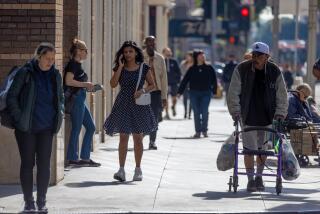Fewer people moving to California, more leaving during the pandemic, study shows

The number of people moving to California from other states has dropped significantly since the beginning of the COVID-19 pandemic, and more Californians are leaving the state, according to a new study released Wednesday.
The two trends signal that population loss due to domestic migration out of the Golden State has more than doubled since the beginning of the pandemic. The pattern has rippled across California: New entrances to the state have dropped in every county since the end of March 2020. When Californians do move, researchers said they are slightly more likely to leave the state than they were before the start of the pandemic.
Entrances to California from other states have dropped 38% since March of last year, while the number of residents leaving to other states has increased 12%, the report from the nonpartisan California Policy Lab said.
“The public’s attention has been focused on the so-called ‘CalExodus’ phenomenon, but the reality is that the dramatic drop in ‘CalEntrances’ since the pandemic began has been a bigger driver of recent population changes in the state,” Natalie Holmes, research fellow at the California Policy Lab, said in a statement.
The study found “no evidence of a pronounced exodus” from the state but showed that net entrances from other states have dropped significantly since the start of the pandemic.
The surge of migration eastward fits a pattern of families escaping densely populated cities, a trend that dates back to the mid-20th century.
“On net today, California loses more than twice as many people to domestic migration as it did before the pandemic,” the report said.
Exits from California increased during the pandemic in eight of the state’s nine economic regions, according to the study, with a 21% increase in the Bay Area compared with a 1% increase in the Northern California region. The share of people who left California increased from roughly 16% in 2016 to 20% at the end of September 2021.
Researchers said that since the end of March 2020, new entrances to Bay Area counties have dropped faster than in other parts of the state.
“By the end of September 2021, there were 45% fewer people moving into the Bay Area from other U.S. states as compared to the beginning of 2020,” said Evan White, executive director of the California Policy Lab’s UC Berkeley site. “San Francisco, San Mateo, and Santa Clara counties have all lost population to domestic migration for the first time since at least 2016 because of these new patterns.”
Some city dwellers who’ve moved to the high desert over the last year and a half looking for more space and clean air also found unexpected drawbacks.
Between 2016 and the start of the pandemic, San Francisco, San Mateo and Santa Clara were the only three California counties that received more people from other U.S. states than they sent to other U.S. states.
Many Californians who moved in 2020 stayed in-state, often trading city life in the Bay Area or Los Angeles for suburban or rural communities. A growing number of families have moved inland over the last few years, data show, fueled by the hunt for more open space, a sense of community and affordable housing.
But the migratory shift grew even more pronounced amid the pandemic, experts say, as the barriers to moving dropped for many in large cities, spurred by a newfound ability to work remotely.
“We don’t try to dig into causes here in this report,” Holmes said. “But we all know someone or know someone who knows someone who moved during the pandemic.”
A new report from the nonpartisan California Policy Lab also found that fewer people are moving to the Golden State.
More to Read
Sign up for Essential California
The most important California stories and recommendations in your inbox every morning.
You may occasionally receive promotional content from the Los Angeles Times.














